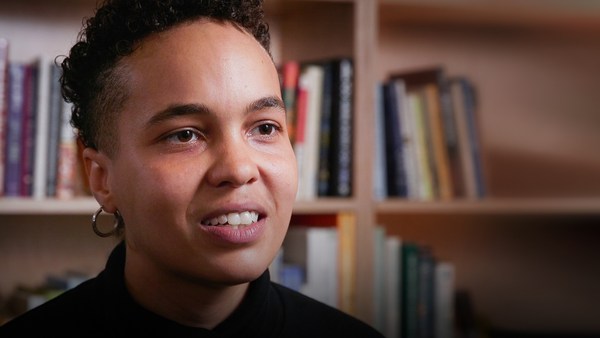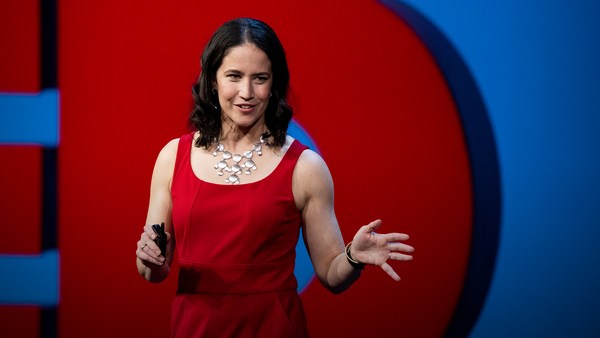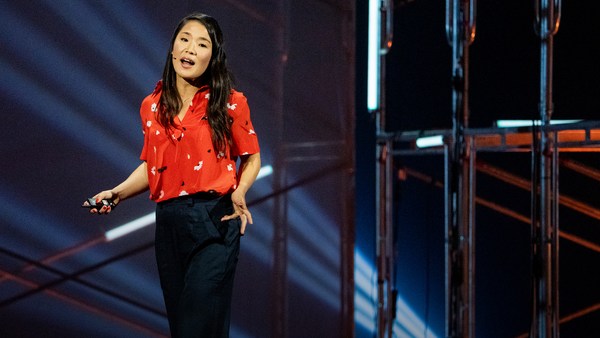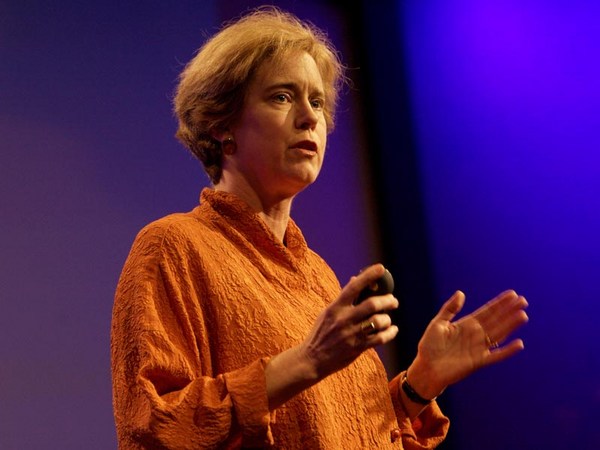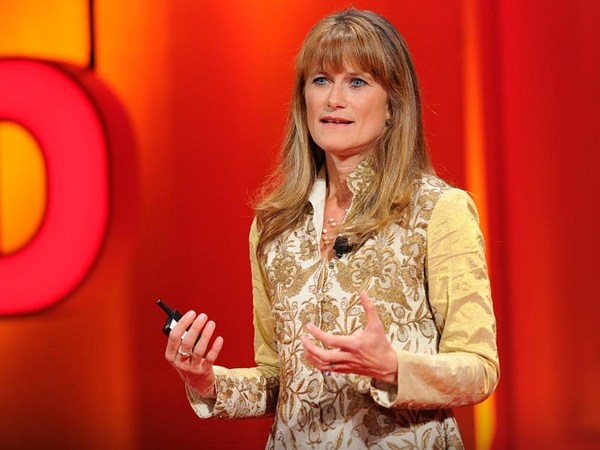I want to invite you over for dinner at my house. When you walk in, there are chairs cramped everywhere, smells delicious, you hear people laughing, you see friends hugging and telling stories. There are more than 20 of us here tonight. Teachers, tech leaders, lawyers, moms. It’s loud, and it’s chaotic. But even if this is your first time, it feels like home. And then we'll sit down to work. Because tonight is not a regular dinner. Tonight is the culmination of months of conversations and learning in my living room. At the end of this night, 30,000 dollars will go out to a local grassroots nonprofit that is doing amazing work in our community. And that money came from everyone in the room. And the decision of where that money is going included all of our voices.
This is a giving circle: a group of people with shared values that comes together to create change. My giving circle, the Peninsula Latina Giving Circle, is what I know philanthropy to be. It's joyful. And transformative and collaborative and intentional. Most people don't see us as philanthropists or this process when they think of philanthropy. But I'm here to show you the powerful possibility that exists in all of us to be philanthropists, no matter your age or your wealth, no matter where you live or where you come from.
I am originally from Mexico City, moved to the US 25 years ago, and in 2007, when I started my first giving circle, I didn't even know the concept had a name. This is not new. Collective giving has been going on for centuries. Just in the past two decades, thousands of giving circles got started all over the world, collectively giving more than 1.3 billion dollars.
(Applause)
I have dedicated my life to this work. And now I lead an organization called Philanthropy Together to democratize and diversify the power of philanthropy through the power of giving circles. There are giving circles with five members or 500, each person giving five dollars or 250,000, iIncluding any generation, identity or geography. We give to nonprofits, we give to individuals or to new projects just getting off the ground. There are women's giving circles and Black giving circles, Jewish, Muslim and interfaith. Giving circles that focus on climate change and civic engagement. Cross-class and cross-race giving circles. Asian Pacific Islanders and Latinx LGBTQ. Giving circles inside companies. And social clubs and virtual. There are giving circles in Malawi and China and Germany.
So these groups keep getting together year over year because collective giving is powerful. We can have a much bigger impact together than we can alone.
So what is the secret? I'm here to show you the four steps to start a thriving giving circle.
The first step is to create belonging. The concept of people banding together to create change is as old as humanity itself. And collective giving has roots in cultures all around the world. But today we don't even talk to our neighbors anymore. But by belonging to something that is bigger than ourselves and the collective power of our dreams and voices, that is what creates that lasting commitment to each other and to change. Now [with] giving circles, you start with a group. Friends, neighbors, colleagues. And you take the time to deepen those relationships. Those folks back in my living room, we basically started as strangers. But because we ate together and laughed together and shared stories and decided on our shared set of values, we ended up creating a lasting community that gets together year over year. Giving circles make you feel at home.
The second step is to hold space for discourse. It can be completely, completely overwhelming to know how to make an impact as an individual. But in a giving circle, you have the opportunity to learn together. Dozens of people engaging in challenging conversations, getting new perspectives about the issues in their communities. We work across differences and ideologies and viewpoints. But because everyone has an equal voice, we always walk in with something to share and walk away with something learned. And back in my living room, we’re tackling the hardest part: to decide where are we giving together. So we'll learn and then we'll vote, and we'll discuss, and we'll change our minds. And then we'll change our minds again. But beyond fail, we always come to an agreement at the end because we come with an open heart and an open mind. Now giving circle, is not about me or you. It's about us together.
And once we have shared and discussed, the third step is to give with trust. Because in a giving circle, we give altogether to a shared pot of funding before even knowing where that money is going to go. We trust each other, and that trust extends to the groups that we're funding. Tonight we're deciding to give to a small nonprofit with a tiny, tiny budget. These numbers may shock you, but in the US, 88 percent of funding goes to just the top five percent of nonprofits. And groups led by Black and Latino leaders get far less funding than similar groups led by white leaders. My giving circle, we give as you would to a loved one, looking them in the eyes. And unlike most of traditional philanthropy, we give with no strings attached, literally shifting the power into the hands of the leaders on the ground, so they can decide how to best use the money.
(Applause)
Because community knows what community needs. For any philanthropist, it should never be about parachuting into a community to “save” it. Just acting alongside in partnership. They don't need to be saved. They need to be trusted.
(Applause)
And the last step is just to act in abundance. When people think of philanthropy, they usually just think of big money. And of course, you know, money is a big part of a giving circle, too. Because of the multiplying effect, my 100 dollars can turn into 10,000 or 100,000. You know, I even can make my kids look outside of their phones for two minutes and pay attention when I'm telling them that I just gave 50,000 dollars. But philanthropy literally is love of humanity. Giving with an abundance of heart and of spirit. We can all be radically generous in so many ways, beyond just money.
So after tonight, we all are going to go and volunteer and advocate and open doors and share in social media. We call this, in giving circles, giving your five Ts: time, talent, treasure, testimony and ties.
One of my favorite stories of abundance is that of Martin Vargas Vega. The son of migrant farm workers whose dream was to become a coder. Martin got trained by a small tech-skills nonprofit in his community. That nonprofit was supported by the Latinos in Tech Giving Circle. And for Martin, it was incredibly powerful to see a group of people that looked like him, supporting and fueling the work of the nonprofit that was training him. So after his training, Martin landed this high-profile internship in Silicon Valley. And the very first thing he did was give 50 percent, half of his signing bonus, to that nonprofit.
(Applause)
And wait. And the other half to join the Latinos in Tech Giving Circle, because he is a philanthropist. Martin is -- thank you. Martin is actively using his voice and his power to bring more STEM programs for kids that look like him. That is abundance. Life changing things happen when we look at philanthropy beyond the money, because all the money in the world is not going to save us. But beloved communities will.
For a long time, philanthropy has been just a select few ... that decide on the impact on many who should and shouldn't get funding, what is and what is not considered impactful. Again, in the US, communities of color receive eight percent of philanthropy. For women and girl's issues, it's just 1.9 percent. Not even one third of one percent goes to the LGBTQ community. We have to change that. When we shift the power of philanthropy into all of our voices, we change who gives, how we give, and ultimately, what gets funded. Giving by, for and with the communities we represent is the future of philanthropy. And each and every one of us belong in this movement.
(Applause)
Just think. What if every town, every issue, every community had a giving circle with passionate philanthropists like you?
So if you're looking for impact and connection and purpose and joy, join or start a giving circle, no matter if you have five dollars to give or 50 million. No matter if you are a teacher or a tech leader or a lawyer or a mom. And if you do have millions or billions to give, join us in this movement. Match a hundredfold or invest alongside a local giving circle.
Thank you so much for coming to my giving circle tonight. In a world that feels heavy, doing philanthropy together fills me with so much joy and hope for the future. Maybe when we started you thought you were only coming for dinner. But actually, you just got an invitation to change a world. Let's meet at your house next time.
(Spanish) Gracias.
(Applause and cheers)
